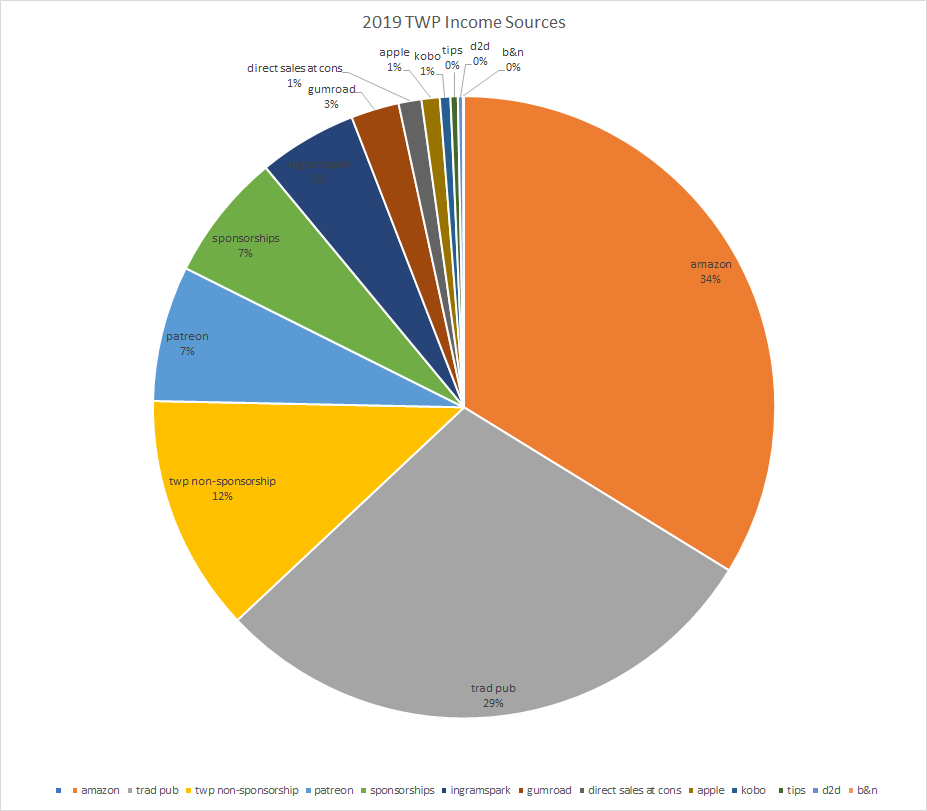I occasionally see authors arguing about what channels to sell through and how to structure their business. I frequently say that I don’t consult. I don’t rely on affiliate or speaking fees. My whole career is built on writing books and getting them in front of readers.
Accomplishing that means making the books available in all possible channels.
Here’s where my money comes from.

For those who want a little more details, here’s the breakdown. (Numbers not exactly 100% due to rounding.)
- 33.7% – Amazon KDP
- 29.2% – Traditional Publishing
- 12.32% – Direct Sales at tiltedwindmillpress.com
- 7.0% – Patreon
- 6.6% – Nonfiction Book Sponsorships
- 5.1% – IngramSpark print distribution
- 2.5% – Gumroad
- 1.2% – direct sales at cons
- 0.9% – Apple iBooks
- 0.6% – Kobo
- 0.4% – tip jar
- 0.3% – draft2digital
- 0.05% – Barnes & Noble
A couple minor sources of income aren’t included–I made about $200 on Amazon affiliate links from my site, and a whopping $6 on Kobo affiliate links. But here’s some rough conclusions.
Amazon is the Big Beast, but it’s not inviolate. It’s not even the majority.
Trad pub certainly sells a bunch through Amazon. Traditional publishers put even more effort into diversification than I do. I’m going to assume that they’re at least as successful as I am, and roughly one-third of my trad pub income comes through Amazon. This means Amazon backs roughly 42% of my income.
I use both IngramSpark and Amazon for print distribution, because IS reaches places Amazon can’t. Last December, someone in China bought both Prohibition Orcs stories via IS. I sell titles in countries I’d never heard of before, thanks to IS.
Direct ebook sales via my web site, Patreon, and book sponsorships combined make up about a quarter of my income. These are clearly worth continuing.
And yes, if you see me at a con, and you want a book, I’ll sell it to you. The income is negligible, but I use direct contact with folks to help build my readership.
You might look at Apple, Kobo, and draft2digital and say “Why bother?” That’s a fair question. The answer is, I want readers. When a reader is intrigued by an author, they go to their favorite bookstore and check out their titles. I want that reader to find my books when the whim hits them, because thirty seconds later they’ll have forgotten about me.
The tip jar is negligible, but costs me nothing to run, so I’ll keep it. It doesn’t encourage me to set up a kofi account, though.
What’s more effective than the tip jar is the “name your price” feature on tiltedwindmillpress.com, which allows folks to pay more than minimum price for a book. Sadly, the NYP plugin I use doesn’t have a feature to separate out how many buyers include extra, but I can say that I frequently see folks offer an extra few bucks. I appreciate every one of you.
Dear Barnes & Noble: please develop life signs. Thank you.
The general summary is: if I was to lose any one income source, I would survive. Losing a big one would be hard. My family relies on my income to pay bills. (My wife works, but if I don’t bring in real money I need to go find a job.)
I find these numbers reassuring. After five years as a full-time writer, I am completely unsuitable for employment.

2 Replies to “2019 Income Sources”
Comments are closed.